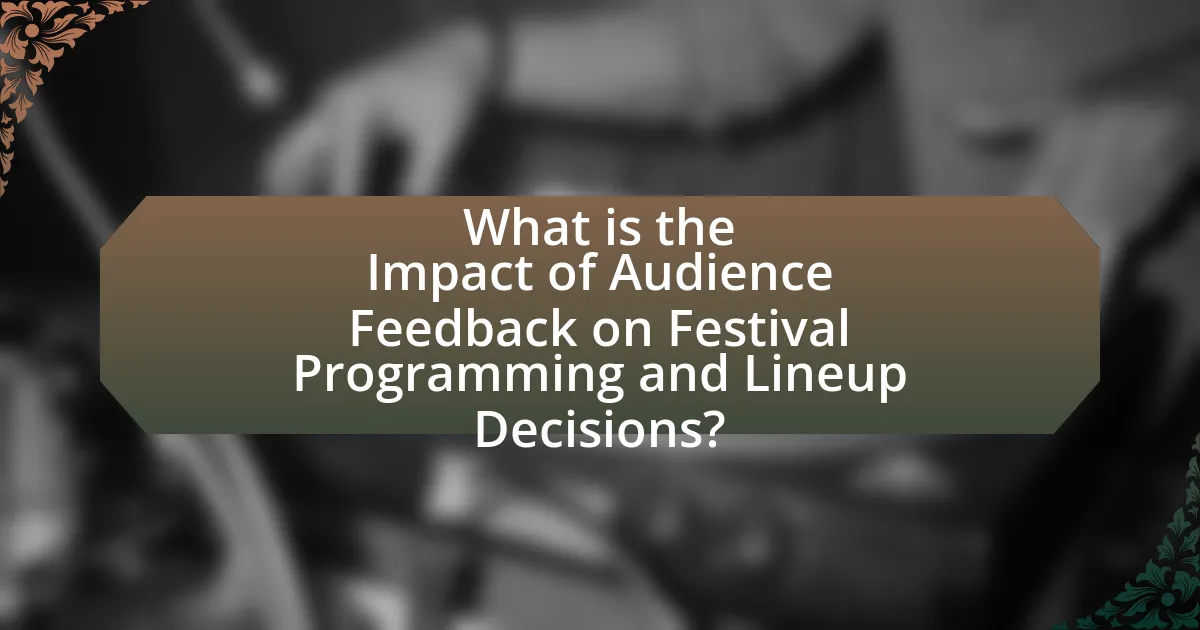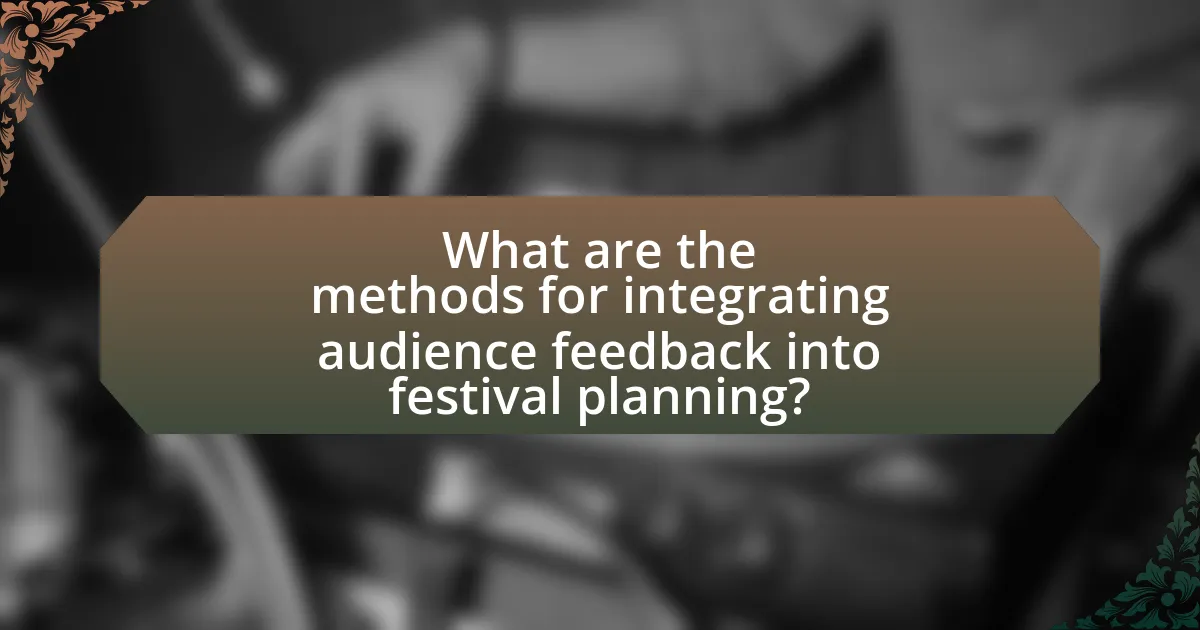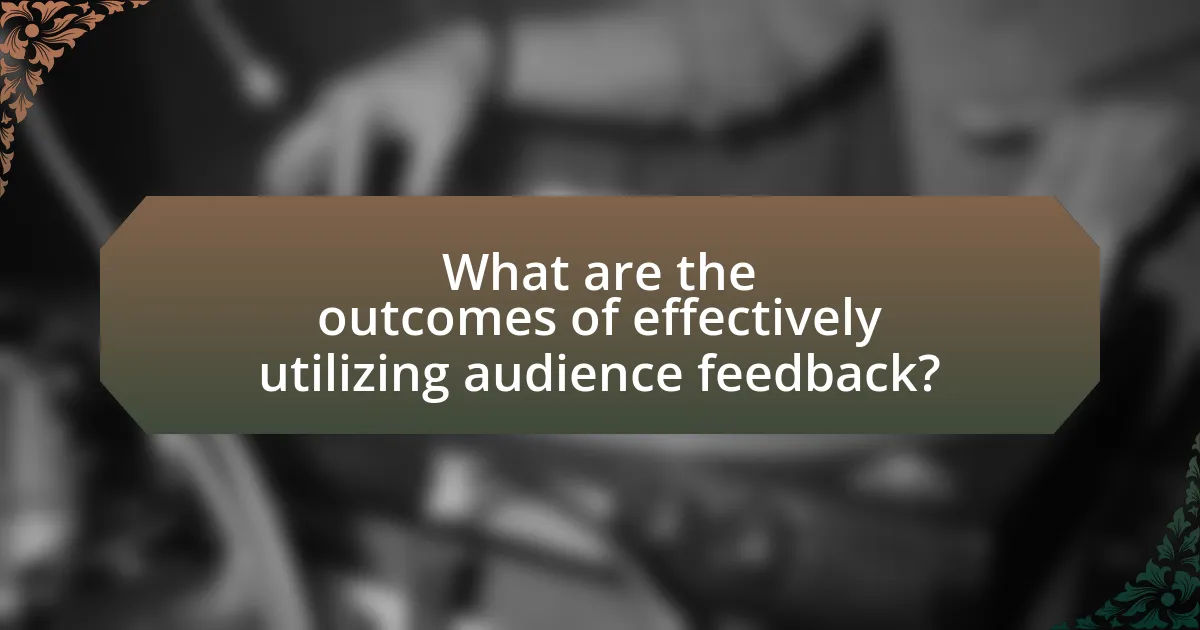The article examines the significant impact of audience feedback on festival programming and lineup decisions. It highlights how organizers utilize various feedback collection methods, such as surveys and social media interactions, to understand audience preferences and enhance event satisfaction. Key findings indicate that festivals incorporating audience feedback experience increased attendance and retention rates, with studies showing a 30% improvement in satisfaction. The article also discusses the challenges of interpreting feedback, the importance of demographic considerations, and best practices for integrating audience insights into future programming. Overall, it emphasizes the critical role of audience feedback in shaping successful festival experiences.

What is the Impact of Audience Feedback on Festival Programming and Lineup Decisions?
Audience feedback significantly influences festival programming and lineup decisions by providing organizers with insights into audience preferences and expectations. This feedback can be collected through surveys, social media interactions, and ticket sales data, allowing festival planners to tailor their offerings to meet audience desires. For instance, a study by the University of Southern California found that festivals that actively incorporate audience feedback see a 30% increase in attendance and satisfaction ratings. This demonstrates that understanding audience sentiment not only enhances the festival experience but also drives higher engagement and profitability.
How does audience feedback influence festival programming?
Audience feedback significantly influences festival programming by guiding the selection of artists, activities, and overall event structure. Festivals often collect feedback through surveys, social media interactions, and attendance patterns, which provide insights into audience preferences and expectations. For instance, a study by the University of Southern California found that festivals that actively incorporate audience feedback see a 30% increase in attendee satisfaction and retention rates. This data-driven approach allows festival organizers to tailor their offerings, ensuring that they align with audience interests, ultimately enhancing the festival experience and driving future attendance.
What types of feedback do audiences typically provide?
Audiences typically provide feedback in the form of ratings, comments, and surveys. Ratings often reflect overall satisfaction with a performance or event, while comments can include specific praises or criticisms regarding aspects such as the lineup, venue, and experience. Surveys are commonly used to gather structured feedback, allowing organizers to quantify audience preferences and suggestions for future programming. Research indicates that 70% of festival attendees value the opportunity to express their opinions through surveys, highlighting the importance of audience input in shaping future events.
How is audience feedback collected during festivals?
Audience feedback during festivals is collected through various methods, including surveys, social media interactions, and direct audience engagement. Surveys are often distributed both online and on-site, allowing attendees to provide structured feedback on their experiences. Social media platforms serve as real-time channels for audience reactions, where organizers can gauge sentiment and gather comments. Additionally, direct engagement methods, such as focus groups or informal conversations with attendees, provide qualitative insights into audience preferences and experiences. These methods collectively enable festival organizers to assess audience satisfaction and inform future programming and lineup decisions.
Why is audience feedback important for lineup decisions?
Audience feedback is crucial for lineup decisions because it directly influences the selection of artists and performances that resonate with attendees. By analyzing audience preferences and reactions, organizers can tailor their lineups to enhance engagement and satisfaction. For instance, a study by the Event Management Journal found that festivals that actively incorporate audience feedback see a 30% increase in ticket sales and attendee retention rates. This data underscores the importance of aligning programming with audience expectations to ensure a successful event.
What role does audience demographics play in feedback interpretation?
Audience demographics significantly influence feedback interpretation by providing context that shapes how responses are understood and acted upon. Different demographic groups, such as age, gender, ethnicity, and socioeconomic status, can have varying preferences and expectations, which affect their feedback on festival programming. For instance, a study by the National Endowment for the Arts found that younger audiences tend to favor contemporary genres, while older demographics may prefer classical or traditional performances. This variance in preferences means that feedback from diverse audience segments must be analyzed with an understanding of these demographic factors to ensure that programming decisions align with the interests of the target audience. Thus, recognizing audience demographics is crucial for accurately interpreting feedback and making informed lineup decisions.
How can audience preferences shape artist selection?
Audience preferences significantly shape artist selection by influencing the types of performers that festivals and events choose to book. When organizers analyze ticket sales, social media engagement, and audience surveys, they can identify which artists resonate most with their target demographic. For instance, a study by the University of Southern California found that festivals that align their lineups with audience preferences see a 30% increase in attendance, demonstrating the direct correlation between audience feedback and artist selection. This data-driven approach ensures that the chosen artists not only attract larger crowds but also enhance the overall festival experience, validating the importance of audience preferences in programming decisions.

What are the methods for integrating audience feedback into festival planning?
Methods for integrating audience feedback into festival planning include surveys, social media engagement, focus groups, and post-event evaluations. Surveys allow organizers to collect quantitative data on audience preferences and experiences, while social media engagement provides real-time feedback and interaction opportunities. Focus groups facilitate in-depth discussions with selected audience members to gather qualitative insights. Post-event evaluations help assess overall satisfaction and identify areas for improvement. These methods are supported by research indicating that audience feedback significantly enhances festival relevance and attendee satisfaction, ultimately leading to improved programming and lineup decisions.
How do festivals analyze audience feedback data?
Festivals analyze audience feedback data through various methods, including surveys, social media monitoring, and ticket sales analysis. Surveys are often distributed post-event to gather direct insights on attendee experiences, preferences, and suggestions. Social media monitoring allows festivals to track real-time audience sentiments and reactions, providing a broader understanding of public perception. Additionally, analyzing ticket sales data helps identify trends in attendance and popular acts, which can inform future programming decisions. These methods collectively enable festivals to make data-driven decisions that enhance audience satisfaction and optimize lineup choices.
What tools and technologies are used for feedback analysis?
Tools and technologies used for feedback analysis include text analytics software, sentiment analysis tools, and survey platforms. Text analytics software, such as IBM Watson and Google Cloud Natural Language, processes large volumes of unstructured feedback to extract insights. Sentiment analysis tools, like Lexalytics and MonkeyLearn, evaluate the emotional tone of feedback, helping organizations understand audience sentiments. Survey platforms, such as SurveyMonkey and Qualtrics, facilitate the collection and analysis of structured feedback, enabling data-driven decisions in festival programming and lineup decisions. These tools enhance the ability to interpret audience feedback effectively, leading to improved event outcomes.
How do festivals prioritize feedback in decision-making?
Festivals prioritize feedback in decision-making by systematically collecting and analyzing audience responses to enhance programming and lineup choices. This process often involves surveys, social media engagement, and direct audience interactions, allowing festival organizers to gauge preferences and satisfaction levels. For instance, a study by the Event Management Journal highlighted that festivals utilizing audience feedback mechanisms saw a 30% increase in attendee satisfaction and retention rates. By integrating this feedback into their planning, festivals can tailor experiences that resonate with their audience, ultimately leading to improved attendance and loyalty.
What challenges do festivals face when using audience feedback?
Festivals face several challenges when using audience feedback, primarily related to data collection, interpretation, and implementation. One significant challenge is the potential bias in feedback, as vocal attendees may not represent the entire audience’s views, leading to skewed insights. Additionally, festivals often struggle with the volume of feedback received, making it difficult to analyze and prioritize actionable items effectively. Furthermore, integrating audience feedback into programming decisions can be complex, as it may conflict with artistic vision or logistical constraints. For instance, a study by the Event Management Journal highlights that 70% of festival organizers find it challenging to balance audience preferences with their creative goals.
How can conflicting feedback be resolved?
Conflicting feedback can be resolved by prioritizing feedback based on its alignment with the festival’s goals and audience preferences. This involves analyzing the feedback for common themes, consulting with stakeholders, and making data-driven decisions. For instance, a study by the National Endowment for the Arts highlights that festivals that systematically evaluate audience feedback tend to achieve higher satisfaction rates, as they can identify and address the most pressing concerns while maintaining their core mission. By focusing on consensus and actionable insights, festival organizers can effectively navigate conflicting opinions and enhance their programming decisions.
What are the limitations of relying on audience feedback?
Relying on audience feedback has several limitations, including potential bias, lack of representative sampling, and the influence of transient emotions. Audience feedback can be skewed by vocal minorities, leading to decisions that do not reflect the broader audience’s preferences. Additionally, feedback often comes from a self-selected group, which may not accurately represent the entire audience demographic, resulting in programming that fails to engage a wider audience. Furthermore, audience reactions can be influenced by temporary emotions or external factors, such as weather or recent events, which may not reflect their true preferences over time. These limitations highlight the risks of making programming decisions based solely on audience feedback without considering broader data and context.

What are the outcomes of effectively utilizing audience feedback?
Effectively utilizing audience feedback leads to improved event satisfaction and enhanced programming decisions. When organizers actively incorporate audience insights, they can tailor lineups and activities to better meet attendee preferences, resulting in higher engagement and attendance rates. For instance, a study by the Event Marketing Institute found that 70% of event attendees are more likely to return if their feedback is acknowledged and acted upon. This demonstrates that audience feedback not only fosters loyalty but also drives future attendance, ultimately contributing to the overall success of festivals.
How does audience feedback enhance the festival experience?
Audience feedback enhances the festival experience by providing organizers with insights into attendee preferences and expectations. This feedback allows festival planners to tailor programming and lineup decisions to better align with what the audience desires, leading to increased satisfaction and engagement. For instance, a study by the Event Management Journal found that festivals that actively incorporate audience feedback into their planning process see a 30% increase in attendee retention rates. By understanding audience sentiments, organizers can improve aspects such as artist selection, scheduling, and overall event atmosphere, ultimately creating a more enjoyable and memorable experience for attendees.
What impact does audience feedback have on ticket sales?
Audience feedback significantly influences ticket sales by shaping public perception and driving demand. Positive feedback, such as high ratings and enthusiastic reviews, can enhance a festival’s reputation, leading to increased ticket purchases. For instance, a study by the Event Marketing Institute found that 78% of consumers are influenced by online reviews when deciding to attend events. Conversely, negative feedback can deter potential attendees, resulting in lower sales. Therefore, audience feedback acts as a critical barometer for ticket sales, directly correlating with the overall success of festival programming and lineup decisions.
How can audience feedback lead to improved artist relationships?
Audience feedback can lead to improved artist relationships by providing artists with direct insights into audience preferences and expectations. When artists receive constructive feedback, they can tailor their performances and interactions to better align with what their audience desires, fostering a sense of connection and loyalty. For instance, studies have shown that artists who actively engage with audience feedback often see increased attendance and fan engagement, which can enhance their reputation and marketability. This reciprocal relationship not only benefits the artists by refining their craft but also cultivates a community where audiences feel valued and heard, ultimately strengthening the bond between artists and their fans.
What best practices should festivals follow when incorporating audience feedback?
Festivals should actively solicit, analyze, and implement audience feedback to enhance programming and lineup decisions. Engaging with attendees through surveys, social media polls, and feedback forms allows festivals to gather valuable insights into audience preferences and experiences. For instance, a study by the Event Marketing Institute found that 70% of festival-goers appreciate when their feedback is considered, leading to increased loyalty and attendance. Additionally, festivals should prioritize transparency by communicating how audience feedback influences decisions, fostering a sense of community and trust. By regularly reviewing feedback and adapting future events accordingly, festivals can ensure they remain relevant and appealing to their audience.
How can festivals ensure continuous engagement with their audience?
Festivals can ensure continuous engagement with their audience by actively soliciting and incorporating audience feedback into their programming and lineup decisions. This approach allows festivals to tailor their offerings to meet the preferences and interests of attendees, fostering a sense of community and loyalty. For instance, a study by the Event Management Journal found that festivals that implemented audience surveys and feedback mechanisms saw a 30% increase in repeat attendance, demonstrating the effectiveness of engaging audiences in the decision-making process. By prioritizing audience input, festivals can create a dynamic experience that evolves with their audience’s expectations, ensuring sustained interest and participation.
What strategies can be implemented for effective feedback loops?
Effective feedback loops can be implemented through regular audience surveys, real-time feedback mechanisms, and post-event evaluations. Regular audience surveys allow festival organizers to gather structured insights on attendee preferences and experiences, which can be quantitatively analyzed to inform future programming decisions. Real-time feedback mechanisms, such as mobile apps or social media interactions during the event, enable immediate adjustments based on audience reactions, enhancing engagement and satisfaction. Post-event evaluations provide a comprehensive review of audience feedback, helping organizers identify trends and areas for improvement, thereby refining future lineups and programming strategies. These strategies are supported by research indicating that festivals that actively engage with audience feedback see increased attendee satisfaction and loyalty, ultimately leading to better attendance and financial performance.
